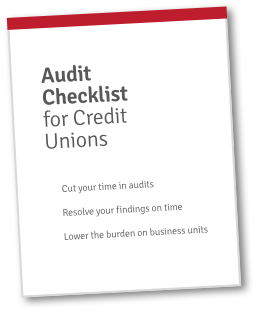Point West Credit Union started off with a robust but time consuming audit program. After partnering with Redboard, they were able to complete their audits much more efficiently and effectively.
The best part?
Their audits now take 20–25% less time than they did before.
So, how did they get from Point A to Point B? Or should we say, from Point East to Point West?
Download a PDF of this Case Study Now >
A World Before Credit Union Audit Management Software
The credit union audit cycle is frequent and time-consuming. It’s not that audits can’t be done (or done right)—they can. The issue is that audits rob credit unions of valuable time that could be spent on important business priorities and member-facing services. Worse, if not managed efficiently, the process can stretch on seemingly forever.
Audits are manageable, but things can quickly get muddled. Everybody involved has demands on their time, and it’s easy to burn hours managing the mechanics of the audit process.
Often, that time that could instead be used to address other important priorities—compliance priorities, business priorities, and member service priorities.
Dealing with the Credit Union Audit Environment
Point West Credit Union noticed that their audit process was manageable, but cumbersome. In an effort to streamline their audit process, they tried several strategies. They involved key experts. They hired an internal auditor. Finally, they turned to Redboard.
Like most credit unions, Point West wasn’t having trouble with their audits, per se. “The audit program of Point West, like most organizations, is fairly manual—or at least, it was,” explains Stephen Pagenstecher, VP of Member Experience at Point West Credit Union. “[There were] lots of emails back and forth, lost items, miscommunications. You know, the program itself was sound, but how it came together and how it aggregated the data, reported it out, was very manual and very cumbersome.”
On its surface, everything at Point West looked fine. They weren’t dealing with any audit horror stories. They had no problems with regulatory action or documents of resolution (DORs).
Where Point West Credit Union Fits In
At just over 100 million dollars, Point West Credit Union isn’t large. Nevertheless, their audit program had grown considerably. They even hired an internal auditor to help.
Still, Point West still felt that their process was poorly optimized. There was a lot of manual-level communication, document preparation, and collection.
Point West’s audit team felt that their audit process was needlessly convoluted. In each audit, as they aggregated documents, they noticed they were spending too much time coordinating, checking for duplicate files, and addressing version control issues.
Their audit process worked, but Pagenstecher and his team felt they needed something to streamline the program so that they could dedicate their time to the audit itself and other key business priorities, and not to the audit process.
Common Issues with the Audit Process
“The credit union regulatory space, in general, is difficult—especially for credit unions of a certain size,” Pagenstecher notes. “Staying on top of all of the compliance—and how it evolves over time—is really difficult.”
Pagenstecher and Point West were dealing with the usual complications associated with smaller credit unions: notably, they have fewer resources in critical areas:
-
- Time
- Personnel
- Money
Accordingly, Point West’s audit team was small and overloaded. Their team comprised heads of different business departments, their CEO, and their auditor. Their time spent on audits actively removed them from member-facing tasks and other important priorities.
Larger credit unions have similar, but different, issues. Larger credit unions have more to keep track of. Both because and in spite of their larger audit teams, they face an increased risk of miscommunications, missing items, version control issues, and allowing items to slip through the cracks.
Looking for a Better Credit Union Audit Solution
Point West Credit Union needed more efficiency through the credit union audit landscape. Their process worked, took too much time.
Pagenstecher and his team started looking for a way to streamline their audits. They knew they needed to optimize their audit environment in two key areas: efficiency and accountability.
1. Efficiency
Point West’s first need was to find a way to increase their efficiency and save time on the audit process. First, they knew they could benefit from automation. Automation would improve: managing version control, building a robust audit trail, and notifying key team members about important items and deadlines. Automation removes micro-managing from the audit process.
Second, Point West needed to know:
-
- What had been done
- What was being done
- What was left to be done
Automation could assist with some of those needs. Also, having a clear view of the above would help them work through their audits more efficiently.
Point West noted that their inefficiencies weren’t just slowing them down—they were increasing risk. Not knowing what had and hadn’t been addressed meant increased risk from:
-
- Missing items
- Miscommunications
- Version control issues
- Repeat findings
- More time spent managing the process
They felt that the audit process could be streamlined so that the above issues would rarely—if ever—pop up. They wanted to spend more time addressing findings and answering questions, and to spend less time coordinating the manner of their efforts.
2. Accountability
Point West also wanted to increase accountability in their audits. Audit teams are built of knowledgeable experts in their field. However, coordinating discrete areas of knowledge isn’t always easy, nor is communication always perfect.
Pagenstecher and his team wanted a better way to keep track of all the moving parts in their audits. They wanted a clearer, more defined vision of people’s responsibilities. Their goal was to keep track of:
-
- Who is working on an item
- Which items are in progress
- When each item is due
Finally, Point West wanted key members of the team to receive updates on progress. Anything else, such as improved or more secure communication, was icing on the cake.
Don’t Call It Audit Software: The Shortcomings of Excel and Outlook for Managing Audits
Unfortunately for Pagenstecher’s team, their audit tools weren’t doing them any favors. They had been working with Microsoft’s Excel and Outlook to manage their audits.
Although Excel and Outlook are fantastic office productivity programs, they fall short for credit union compliance purposes. They were too clunky and cumbersome to handle the needs of a robust credit union audit program.
It’s ironic, but productivity software was hindering Point West’s productivity.
Where Outlook Fell Short
Outlook is a great calendar and email tool. It’s flexible enough to handle most business needs with ease.
However, Outlook’s flexibility is also its weakness. By trying to work for so many purposes, it compromises utility in specialized circumstances.
Point West’s audit team had to deal with a couple major issues with Outlook:
- It was easy to lose track of current audit items, changes, and other critical information over email.
Point West’s process involved a lot of email communication and documents shared over their network. Tracking changes and maintaining version control was difficult without the right tools to manage their audit documents.
2. Outlook offered no effective solutions for older, ongoing audits.
Document storage, communications, and their audit trail were even harder to manage on audits with long remediation timeframes.
Where Excel Fell Short
“[Excel] was a great way to aggregate some of the data, but the problem was that when you take all that information and try to have multiple people working on it together—responses to any audit findings, changing target dates—none of that was captured,” said Pagenstecher. “And then, it was all done manually. So, anytime something changed, there wasn’t an audit trail of who made the change and why.”
Pagenstecher was right. Issues stemming from Excel were robbing Point West’s team of hours of productive time.
To start with, spreadsheets require significant manual input, which is both time-consuming and tedious—two factors that increase the risk of human error.
Also, Point West noticed that as documents were shared, multiple versions of those documents started floating around. This led to version control issues that required lengthy follow-up communications with the team to resolve them.
Another issue was that there’s no audit trail when using Excel. Point West’s audit team didn’t always know:
-
- If something had changed
- What exactly had been changed
- Who made the change
- Why the change was made
- When the change was made
Sometimes, an item that was previously marked as completed would suddenly appear incomplete. Issues like that took extensive communication and coordination to resolve, which complicated the audit process even further.
Automating any of those steps—from input to audit trail—could save significant time and money for their credit union. It would also take out a lot of the guesswork and audit management.
Pagenstecher noted that during audits, it became “really hard for us to aggregate all that data in a meaningful way, and then report back out to the supervisory committee, to the board, and even to our own team,” Pagenstecher said. “And it’s because we were sending around multiple emails with multiple Excel files trying to address all of the findings at once.”
Point West didn’t want to spend their time coordinating, communicating, compiling, double-checking, and building an audit trail. They wanted to address their items and move on quickly and efficiently.
Identifying the Problem Was the Hard Part—Solving It Was Easy
Once Pagenstecher and Point West realized how much time Outlook and Excel cost them, they looked for better ways to manage their audit process.
After a little digging, they discovered Redboard’s external audit management and credit union compliance software.
Redboard’s audit management and credit union compliance platform checked all the boxes that Point West Credit Union was looking for. They didn’t want to relearn how to conduct an audit—they were already well-versed in that area. What they wanted was to find a system that could fit into the way they already did things.
Point West’s audit team and their internal auditor had several conversations with Redboard. They explained to Redboard how their program operated, and Redboard made sure they were able to deliver the same audit experience as before, but without all the hassle.
Pagenstecher was thrilled that Redboard “allowed them to aggregate data, work on things collaboratively, and then have an audit trail and ability to report” to whomever they needed in a more effective manner. Essentially, he said, “our audit environment is very similar, except it works now.”
Measurable Results
Point West estimates that they’re seeing time savings of about 20–25% in their audits.
Most of that time savings comes on the mechanics side of things. For example, they simplified the management of responsibilities, due dates, and follow-up procedures.
Another area Point West was able to save time was in communication and coordination. They appreciated that Redboard helped them reinforce their existing audit process structure.
Finally, they were better able to access older audit information. Having past answers and documents available in a structured repository helped them better reference and leverage the work they’d already done. They no longer needed to track down files on shared drives, inboxes, and so on.
Point West also saved time on the delivery side of their audits. Preparing reports for supervisory committees, auditors, or examiners was a little slow and clunky before, with checking (and double checking) for completion and accuracy.
They were able to save considerable time in collecting deliverables and generating reports. Automation removed a lot of the preparation for collection and delivery work. They were more confident that the particulars—the uncrossed T’s and undotted I’s—were shipshape and good to go.
Happy Endings
Point West Credit Union’s audit program was always robust. Their history of clean, commendable audits indicated that they would have minimal audit troubles long into the future.
However, their high standards for their own work drove them to reevaluate the weakest links in their audit process. Their office productivity software hindered their expertise.
By leveraging Redboard’s secure, central hub, each member of Point West’s audit team was able to work more efficiently. Combining their audit experience with specialized audit management software, they started finishing audits in much less time than it usually took.
They reinvested their newfound time in a couple ways:
- Right off the bat, Point West saw the opportunity to invest more time in their audits. Today, they focus more intently on smaller details to ensure consistency and accuracy.
Similarly, they dedicate more time to reviewing deliverable materials. Their increased efficiency allows them the chance to provide high-quality audit reports and deliverables.
- Point West now dedicates more time to strategic priorities. Their executives now spend more time on other important priorities, including compliance, operations, and member-facing initiatives.
Point West Credit Union’s audit program is stronger than ever. They confidently and reliably handle multiple ongoing audits with ease. Plus, they’re better equipped to draw from their experience and their veteran audit history.


 Get FREE Access to the Audit Checklist for Credit Unions!
Get FREE Access to the Audit Checklist for Credit Unions!


